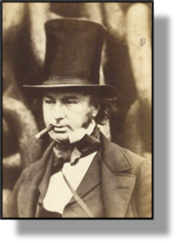 xxxxxThe wooden paddle steamer The Great Western, specifically designed and built for cross-Atlantic service by the English engineer Isambard Kingdom Brunel, was completed in 1837. Weighing 1,320 tons, 212ft in length, and with four boilers to provide steam for its huge paddle wheels, it was the largest ship in the world. It made its maiden voyage the following year and, at an average speed of 9 knots, crossed the Atlantic from Bristol to New York in 15 days - half the time taken by a sailing ship. Over the next twenty years Brunel, a man of great drive and originality, produced two other large steamships, completed over 1,000 miles of railway line for the Great Western Railway, and designed a number of spectacular bridges, including the Clifton Suspension Bridge over the River Avon at Bristol (illustrated below), and the Saltash Bridge over the River Tamar near Plymouth. Noteworthy too is his two-mile long Box Tunnel, dug through Box Hill when laying the railway line between Bath and Chippenham.
xxxxxThe wooden paddle steamer The Great Western, specifically designed and built for cross-Atlantic service by the English engineer Isambard Kingdom Brunel, was completed in 1837. Weighing 1,320 tons, 212ft in length, and with four boilers to provide steam for its huge paddle wheels, it was the largest ship in the world. It made its maiden voyage the following year and, at an average speed of 9 knots, crossed the Atlantic from Bristol to New York in 15 days - half the time taken by a sailing ship. Over the next twenty years Brunel, a man of great drive and originality, produced two other large steamships, completed over 1,000 miles of railway line for the Great Western Railway, and designed a number of spectacular bridges, including the Clifton Suspension Bridge over the River Avon at Bristol (illustrated below), and the Saltash Bridge over the River Tamar near Plymouth. Noteworthy too is his two-mile long Box Tunnel, dug through Box Hill when laying the railway line between Bath and Chippenham.
xxxxxBrunelxwas born in Portsmouth, the only son of Marc Isambard Brunel (1769-1849), a French engineer who had escaped to the United States during the French Revolution, and had come to work in London in 1799. The young Brunel received part of his education in France, and then helped his father in the construction of the world’s first under-water tunnel, built under the River Thames from Wapping to Rotherhithe. He was appointed resident engineer under his father’s direction when work began in 1825, but he left three years later when part of the tunnel was flooded - killing six workers - and the project was put on hold. (It was not finished, in fact, until 1843.)
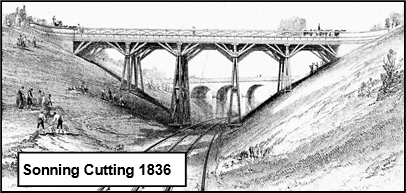 xxxxxIn 1833 he was tasked with making extensive improvements to the docks at Bristol - the first of many such assignments - and it was while working on this project that he became interested in the building of railways, then very much in its infancy. He became chief engineer to the Great Western Railway that same year, and over the next twenty years built more than 1,000 miles of permanent track in the West Country, the Midlands and South Wales. In addition, he laid down two railway lines in Italy, and advised on the construction of lines in South Australia and East Bengal in India. On his advice the Great Western Railway adopted a gauge of 7ft, but a narrower gauge of 4ft 8.5 ins had already been adopted in the north - based on the width of the local coal wagons -, and this led to the so-called “battle of the gauges”. The narrow one was eventually adopted throughout Britain and this also became the standard in many countries overseas, including the United States from 1885.
xxxxxIn 1833 he was tasked with making extensive improvements to the docks at Bristol - the first of many such assignments - and it was while working on this project that he became interested in the building of railways, then very much in its infancy. He became chief engineer to the Great Western Railway that same year, and over the next twenty years built more than 1,000 miles of permanent track in the West Country, the Midlands and South Wales. In addition, he laid down two railway lines in Italy, and advised on the construction of lines in South Australia and East Bengal in India. On his advice the Great Western Railway adopted a gauge of 7ft, but a narrower gauge of 4ft 8.5 ins had already been adopted in the north - based on the width of the local coal wagons -, and this led to the so-called “battle of the gauges”. The narrow one was eventually adopted throughout Britain and this also became the standard in many countries overseas, including the United States from 1885.
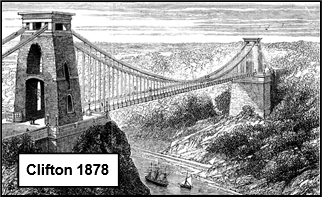 xxxxxHis work on the extension of the railways inevitably led to the design and construction of many tunnels, bridges and viaducts. One of his first major bridges was the Maidenhead Bridge, and it was here that he pioneered the use of compressed-air “caissons”, cylindrical or boxlike metal shells, to sink the pier foundations into the riverbed. His bridge over the River Avon at Bristol, not completed until 1864, was an impressive piece of engineering (illustrated), and he used tubular arches and chain cable in the construction of the Saltash Bridge - nearly 2,250 ft long - over the River Tamar. Many of his works have survived, but his pine timber viaducts in the South-West required replacement within 50 years or so.
xxxxxHis work on the extension of the railways inevitably led to the design and construction of many tunnels, bridges and viaducts. One of his first major bridges was the Maidenhead Bridge, and it was here that he pioneered the use of compressed-air “caissons”, cylindrical or boxlike metal shells, to sink the pier foundations into the riverbed. His bridge over the River Avon at Bristol, not completed until 1864, was an impressive piece of engineering (illustrated), and he used tubular arches and chain cable in the construction of the Saltash Bridge - nearly 2,250 ft long - over the River Tamar. Many of his works have survived, but his pine timber viaducts in the South-West required replacement within 50 years or so.
xxxxxBrunel was a man who liked a challenge. When the railway track to Bristol had been completed he refused to see it as the end of the line. He turned his hand to the building of huge vessels to cross the Atlantic Ocean, and in the process became the greatest ship designer of his day. After his completion of the Great Western - financed, incidentally by the Great Western Steamship Company, an offshoot of the Great Western Railway - he began work on an even larger ship, the Great Britain. Fitted with an iron hull and six masts, it was 322 ft long and weighed 3,270 tons. Originally intended to have even bigger paddle wheels than those of the Great Western, in 1839 the Scottish engineer James Nasmyth (1808-1890), a one-time assistant to the English tool maker Henry Maudslay, invented a powerful steam hammer to forge the huge drive shaft. As it so happened the Great Britain, launched in 1843, was eventually driven by a screw propeller - thereby becoming the first propeller-driven iron ship to cross the Atlantic -, but needless to say, Nasmyth’s steam hammer quickly became a vital industrial tool.
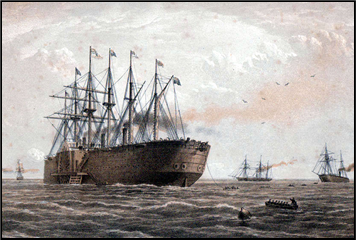 xxxxxBrunel’s last ship, the Great Eastern (illustrated) - with six masts and four funnels - was so gigantic that it remained the largest ship afloat until the end of the century. It was built with a double iron hull - the first of its kind - and was driven by both paddles and a screw propeller. Weighing nearly 19,000 tons, 692 feet in length and with immense storage for coal, it was designed to make a round trip to Australia without refuelling. However, it was beset with problems at its launching in 1857, and, after seeking the advice of the English engineer William Froude, Brunel had to provide bilge keels to ensure greater stability. At the same time, the project ran into money problems and this, together with the report of an explosion on board the vessel in 1859, doubtless contributed to Brunel’s sudden death. He died of a stroke in the September. The steamship eventually made its maiden voyage in 1860, and crossed the Atlantic in 11 days, but whilst it confirmed the possibility of building such large iron ships, it was not a commercial success, and was taken out of service in 1864.
xxxxxBrunel’s last ship, the Great Eastern (illustrated) - with six masts and four funnels - was so gigantic that it remained the largest ship afloat until the end of the century. It was built with a double iron hull - the first of its kind - and was driven by both paddles and a screw propeller. Weighing nearly 19,000 tons, 692 feet in length and with immense storage for coal, it was designed to make a round trip to Australia without refuelling. However, it was beset with problems at its launching in 1857, and, after seeking the advice of the English engineer William Froude, Brunel had to provide bilge keels to ensure greater stability. At the same time, the project ran into money problems and this, together with the report of an explosion on board the vessel in 1859, doubtless contributed to Brunel’s sudden death. He died of a stroke in the September. The steamship eventually made its maiden voyage in 1860, and crossed the Atlantic in 11 days, but whilst it confirmed the possibility of building such large iron ships, it was not a commercial success, and was taken out of service in 1864.
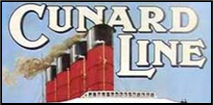 xxxxxBrunel, one of the most brilliant engineers of his day, dominated the British industrial scene during the period 1833 to 1859. His contribution to the development of the railways was immense, and he gained a reputation as a remarkable bridge builder. In shipbuilding he dared to think big and, in so doing, brought in a number of important innovations. But it was the Cunard Line, founded in 1839 by the British merchant Samuel Cunard (1787-1865) and others, which provided the first regular steamship service to North America. The following year, having won the government’s contract to carry mail across the Atlantic, the company launched four paddle steamers, the Britannia, Acadia, Columbia and Caledonia. By 1847 ten ships were making the run, the first in a long line of steamers. They became screw-propelled as from 1862, and gained a reputation for speed and safety.
xxxxxBrunel, one of the most brilliant engineers of his day, dominated the British industrial scene during the period 1833 to 1859. His contribution to the development of the railways was immense, and he gained a reputation as a remarkable bridge builder. In shipbuilding he dared to think big and, in so doing, brought in a number of important innovations. But it was the Cunard Line, founded in 1839 by the British merchant Samuel Cunard (1787-1865) and others, which provided the first regular steamship service to North America. The following year, having won the government’s contract to carry mail across the Atlantic, the company launched four paddle steamers, the Britannia, Acadia, Columbia and Caledonia. By 1847 ten ships were making the run, the first in a long line of steamers. They became screw-propelled as from 1862, and gained a reputation for speed and safety.
xxxxxThe Great Western ended its days carrying troops to the Crimean War, and was broken up in 1856. The Great Britain, however, survived in one piece, and is now to be seen in the Bristol dry dock in which it was constructed. And despite its failure as a passenger ship, the Great Eastern went on to gain fame as a cable ship. It successfully laid down the telegraph cable across the Atlantic in 1866 (Vb) - after five previous attempts had failed - and in 1870 it laid the Bombay-to-Aden cables to Europe. In the meantime, the French emperor, Napoleon III, chartered it to carry Americans (including the young French writer Jules Verne) to the Paris Exhibition of 1867. It served as a showboat during its final years until broken up for scrap metal in 1888.
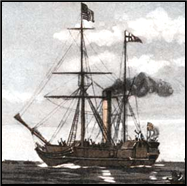
xxxxxIncidentally, despite Brunel’s plans, it was the little British ship Sirius, carrying 40 passengers, which, in 1838, was the first vessel to cross the Atlantic entirely under steam power. It ran short of fuel towards the end of the voyage, but the captain, refusing to hoist the sails, ordered the burning of the ship’s spars and furniture to keep the boilers going. We are told that the ship managed to reach New York just a few hours before the arrival of the Great Western! ……
xxxxx…… During the Crimean War, Brunel designed an armoured barge to bombard the Russian naval port of Kronstadt, and he also produced the plans for a hospital building which was shipped out to the Crimea in parts and reassembled on arrival. ……
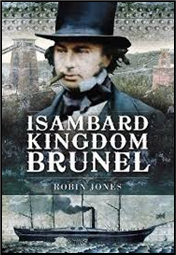 xxxxx…… The huge Great Eastern was due to be launched in November 1857 but, to Brunel’s embarrassment and the consternation of the ten thousand people who attended the ceremony, it slid just four feet down the slipways and then came to a halt. It was not until the end of January 1858 that the huge craft, inched slowly forward by a series of hydraulic rams, was floated off on the tide. In the meantime, suggestions from the general public to achieve the launch included putting hard mutton fat on the slipways, and the use of a large number of bladders filled with gas to lessen the ship’s weight! The funny side apart, one man was killed during the launch, and six more when an explosion occurred aboard during the vessel’s sea trials in September 1859. ……
xxxxx…… The huge Great Eastern was due to be launched in November 1857 but, to Brunel’s embarrassment and the consternation of the ten thousand people who attended the ceremony, it slid just four feet down the slipways and then came to a halt. It was not until the end of January 1858 that the huge craft, inched slowly forward by a series of hydraulic rams, was floated off on the tide. In the meantime, suggestions from the general public to achieve the launch included putting hard mutton fat on the slipways, and the use of a large number of bladders filled with gas to lessen the ship’s weight! The funny side apart, one man was killed during the launch, and six more when an explosion occurred aboard during the vessel’s sea trials in September 1859. ……

xxxxx…… The first ship of the Cunard Line to cross the Atlantic was the Britannia. With Samuel Cunard himself at the helm, it took 14 days 8 hours. In recognition of his service to British shipping, Cunard was created a baronet in 1859. ……
xxxxx…… Brunel University, founded at Uxbridge, West London, in 1966, is named after both the Brunels, father and son.



 xxxxxThe wooden paddle steamer The Great Western, specifically designed and built for cross-
xxxxxThe wooden paddle steamer The Great Western, specifically designed and built for cross- xxxxxIn 1833 he was tasked with making extensive improvements to the docks at Bristol -
xxxxxIn 1833 he was tasked with making extensive improvements to the docks at Bristol - xxxxxHis work on the extension of the railways inevitably led to the design and construction of many tunnels, bridges and viaducts. One of his first major bridges was the Maidenhead Bridge, and it was here that he pioneered the use of compressed-
xxxxxHis work on the extension of the railways inevitably led to the design and construction of many tunnels, bridges and viaducts. One of his first major bridges was the Maidenhead Bridge, and it was here that he pioneered the use of compressed- xxxxxBrunel’s last ship, the Great Eastern (illustrated) -
xxxxxBrunel’s last ship, the Great Eastern (illustrated) - xxxxxBrunel, one of the most brilliant engineers of his day, dominated the British industrial scene during the period 1833 to 1859. His contribution to the development of the railways was immense, and he gained a reputation as a remarkable bridge builder. In shipbuilding he dared to think big and, in so doing, brought in a number of important innovations. But it was the Cunard Line, founded in 1839 by the British merchant Samuel Cunard (1787-
xxxxxBrunel, one of the most brilliant engineers of his day, dominated the British industrial scene during the period 1833 to 1859. His contribution to the development of the railways was immense, and he gained a reputation as a remarkable bridge builder. In shipbuilding he dared to think big and, in so doing, brought in a number of important innovations. But it was the Cunard Line, founded in 1839 by the British merchant Samuel Cunard (1787-
 xxxxx…… The huge Great Eastern was due to be launched in November 1857 but, to Brunel’s embarrassment and the consternation of the ten thousand people who attended the ceremony, it slid just four feet down the slipways and then came to a halt. It was not until the end of January 1858 that the huge craft, inched slowly forward by a series of hydraulic rams, was floated off on the tide. In the meantime, suggestions from the general public to achieve the launch included putting hard mutton fat on the slipways, and the use of a large number of bladders filled with gas to lessen the ship’s weight! The funny side apart, one man was killed during the launch, and six more when an explosion occurred aboard during the vessel’s sea trials in September 1859. ……
xxxxx…… The huge Great Eastern was due to be launched in November 1857 but, to Brunel’s embarrassment and the consternation of the ten thousand people who attended the ceremony, it slid just four feet down the slipways and then came to a halt. It was not until the end of January 1858 that the huge craft, inched slowly forward by a series of hydraulic rams, was floated off on the tide. In the meantime, suggestions from the general public to achieve the launch included putting hard mutton fat on the slipways, and the use of a large number of bladders filled with gas to lessen the ship’s weight! The funny side apart, one man was killed during the launch, and six more when an explosion occurred aboard during the vessel’s sea trials in September 1859. ……


